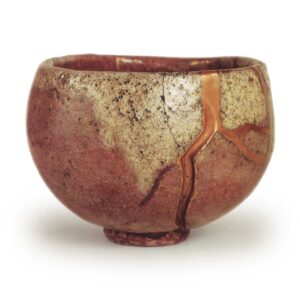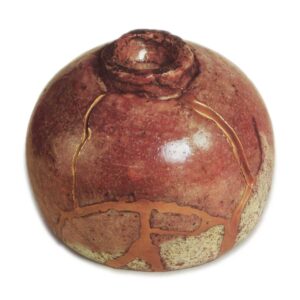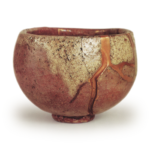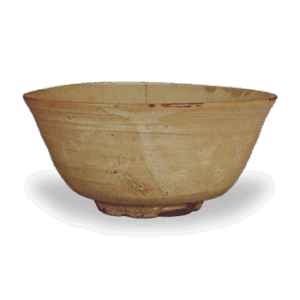

Important Cultural Property
Held at: Hatakeyama Memorial Museum
Height: 9.2 – 9.5 cm
Diameter: 11.0 – 11.6 cm
Outer diameter of foot ring: 4.1 – 4.2 cm
Height of foot ring: 1.0 cm
The name “Seppou” was probably given because the magnificent white snowdrift that runs from the rim to the body of the bowl is just like a mountain peak covered in snow.
It is listed as one of Koetsu’s five or seven types of tea bowls, and, along with Bishamon-do, it has been famous since ancient times as one of the two great Koetsu red tea bowls. The unique rounded shape of the pot, with its full, bulging body, is reinforced by the bold self-sinking of the large crack, which further strengthens the intense impression of this tea bowl.
The pot is slightly thick-walled, and the rim is held in place by the body, which is strongly tapered from the body to the foot. The characteristic crackle that Koetsu was so fond of can be seen in some parts, and the crackle is particularly intense in this tea bowl, and the effect is heightened even further by the gold repairs. It seems that Koetsu fired the tea bowl at a high temperature without paying any attention to it, and the crackle is thought to be due to this, and it has become a characteristic feature and a major highlight.
The entire piece is covered in a glaze, which is Koetsu’s distinctive glassy glaze, or Koetsu glaze, and is beautifully shiny. Due to the mixture and uneven firing, there are white pools and unevenness inside and outside, even on the foot ring, but this makes the intense red of the base material shine through, making it beautiful and attractive.
The white sloping from the rim to the body is thought to be due to the double glazing, and the white of the loss of transparency, in particular, is vivid and contrasts strongly with the red of the clay body. The inside of the bowl is wide, and the center of the tea pool is slightly raised, but it is also covered in white. The foot ring has five eyes, and the intensity of the inner carving fully expresses the distinctive use of the spatula by Koetsu, and the cracks on the side add to its strength.
In other words, the bold and spirited style of Koetsu himself, combined with the intense firing, unexpectedly produced the Seiho tea bowl here. At first glance, it seems to fit snugly in the palm of your hand, but as you hold it, you can feel the intense power that seems to spread outwards.
This is a tea bowl that is on a par with Fujiyama as a Koetsu box, and it was probably made in the Takagamine kiln in his later years.
Accessories
inner box, lacquered with a pattern of waves, gold powder lettering on the lid, Koetsu “Seppou Daikyokan
Originally owned by the Mitsui family, it later passed to the Sakai family, who were the feudal lords of Himeji Castle, but in recent years it came into the possession of the tea master Hatakeyama Ippei, and is now in the collection of the Hatakeyama Memorial Museum.








